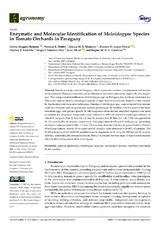Enzymatic and Molecular Identification of Meloidogyne Species in Tomato Orchards in Paraguay
Autor
Resquín Romero, Gloria Arminda
Mattos, Vanessa S.
Monteiro, Jessica M. S
Lopez-Nicora, Horacio D.
Amarilla, Shyrley P.
Chamorro-Diaz, Sergio
Moral, Juan
Carneiro, Regina M. D. G.
Editor
MDPIFecha
2023Materia
Esterase phenotypeMeloidogyne incognita
Meloidogyne javanica
Root-knot nematode
SCAR markers
METS:
Mostrar el registro METSPREMIS:
Mostrar el registro PREMISMetadatos
Mostrar el registro completo del ítemResumen
Tomato is a major crop in Paraguay, where it provides a source of employment and income for households. Tomato production can be affected by root-knot nematodes, especially Meloidogyne spp. The unequivocal identification of Meloidogyne spp. in Paraguay has not been conducted yet. This study aims to identify Meloidogyne species in eight tomato production districts of this country by biochemical and molecular techniques. Females of Meloidogyne spp. were extracted from tomato roots and characterized using esterase isozyme phenotypes. In addition, DNA was extracted from nematode eggs, and species-specific SCARs (sequence-characterized amplified regions) were used to confirm the diagnosis. Nematodes were detected in 100% of studied samples (prevalence), of which M. incognita (Est: I2, Rm: 1.1;1.2) and M. javanica (Est: J3, Rm: 1.0, 1.20, 1.35) were present in 39.13% and 26.08% of samples, respectively. One population (8.69%) of Meloidogyne sp. presenting an atypical esterase profile (Rm: 1.0 and 1.3) was only detected in Julián Augusto Saldívar District. Mixed populations, mostly M. incognita and M. javanica, were observed in 26.08% of samples. The SCAR primers incK14F/incK14R amplified specific fragments for M. incognita (399 bp) and M. javanica (670 bp), confirming the enzymatic results. Here, we present the first study of root-knot nematode identification at the species level in Paraguay.

